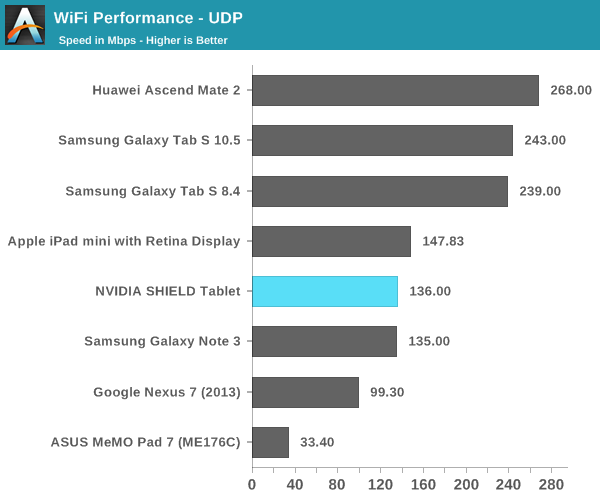The NVIDIA SHIELD Tablet Review
by Joshua Ho on July 29, 2014 9:00 AM ESTWiFi Performance
For the most part these days it seems that the situation for WiFi is much better in mobile than it is anywhere else, but it's still important to test throughput, especially on a device like the Shield tablet that requires low latency, high bandwidth connections in order to support GameStream and GRID. To this end, while NVIDIA hasn't shipped 802.11ac the Shield tablet ships with a 2x2 antenna configuration for a maximum PHY rate of 300 Mbps. Like the Shield portable, this is a BCM43241 chip, likely shared to improve economies of scale. To look at how it performs, we turn to iperf. Before we get into the results of the test, I'd like to thank ASUS for providing the RT-AC68U router to test WiFi perfomance.

Surprisingly, the Shield tablet performs about as well as some single stream 802.11ac solutions like the one found in the Galaxy Note 3. Performance is generally in line with what we'd expect for such a solution, although it would be nice to see 802.11ac for future products.
Camera
While I currently don't have the means to properly test camera, there are still some things to talk about for camera. Both the front and rear camera modules use OmniVision's OVT5963 sensor, which appears to be a 1/4", 5MP sensor. The rear camera has an F/2.0 aperture with 2.95mm focal length, and the front camera has an F/2.8 aperture, with a claimed 4.76mm focal length, although the field of view appears to be somewhat wider. This is the same sensor as the camera in the Nexus 7 (2013). As a rear facing camera, the quality is nothing special but as a front facing camera it's surprisingly high quality. The photo above is with the rear facing camera, the photo below is from the front facing camera. The stock camera application also doesn't show the correct aspect ratio for the camera, so the preview is cropped.
Audio
While I don't have the equipment available to test audio quality and peak volume quite yet, subjectively the two bass reflex ports and dual front facing speakers make for a great experience. It's definitely a major advantage over other devices when it comes to watching movies and playing games as I don't have to cup my hand around the speaker. The larger size of the tablet formfactor means that the stereo separation is much more obvious. On the headphone jack, the device appears to be using a Realtek RT5639 codec. It seems that NVIDIA has continued to use their own speaker protection system that runs on the SoC, as there isn't any clear evidence of a speaker protection IC connected via I2C.












174 Comments
View All Comments
Knowname - Wednesday, July 30, 2014 - link
you make a good point, and one I actually considered when I looked for a new toy half a month ago. The Nexus7 (2013) would be just fine for my needs. THAN I saw this out of the corner of my eye and yes, I'll admit I WAS wooed somewhat by the false fantasy that is the 'latest and greatest'. The Nexus 7 is just fine and half the price! In the end though I succumbed to consumerism and though I like to think I'm very frugal I think I made a good deal.Bottom line, it's more than just a little snappier, it's THREE TIMES as snappy! The speakers are an upgrade, the connectivity is an upgrade, SD card compatible and best of all a great selfie camera!! xD ok I kid. Anyway forget the gamestreaming stuff (though... a definite plus if you leave your computer on 24x7) it's still very future proof I won't need to upgrade my tablet for at least a couple years with this!
Unfortunately I bought a GT630 along with this hoping it'd do the trick for gamestreaming but... I don't think it will by what I hear... why just the energy hog GTX cards?? Like I'm gonna leave a GTX based computer on 24x7 just so I can use it more on a remote basis? *ahem* not likely... hopefully they come out with some extremely low power GTX cards in the future.
fivefeet8 - Thursday, July 31, 2014 - link
Gamestream works with the recent Maxwell GTX 750 Ti. Probably one of the best if not the best performance per watt card out now. Plus most video cards use much lower power during idle.Knowname - Thursday, July 31, 2014 - link
but when your playing it it won't be idle. The GTX750ti may be my best bet, once I can get one for like 80 bucks I'll jump on it!phoenix_rizzen - Tuesday, July 29, 2014 - link
Small correction: First line of second paragraph:"NVIDIA is becoming the first tablet to launch a serious gaming tablet"
Guessing that "first tablet to launch" should be "first OEM to launch" or maybe "first hardware manufacturer to launch".
phoenix_rizzen - Tuesday, July 29, 2014 - link
Page 2, Console Mode paragraph:"Finally, there’s the aspect of GameStream and GRID, which make it possible for games to be played on the tablet that would otherwise wouldn’t work due to the compute requirements."
There's one to many "would" in that line. Guessing it's supposed to be "that wouldn't otherwise work".
Death666Angel - Tuesday, July 29, 2014 - link
Second paragraph:"today NVIDIA is becoming the first tablet to launch a serious gaming tablet running Android. "
Probably supposed to mean "first manufacturer" or something along those lines. :D
JoshHo - Tuesday, July 29, 2014 - link
Well, that's embarrassing. Typo corrected.SleepyItes - Tuesday, July 29, 2014 - link
Tegra K1 should support OpenGL ES 3.0, right? So, I wonder if it would be able to run the Dolphin (GameCube and Wii) emulator? The regular shield is awesome for running everything from NES to PSP (and even some NDS games), but being able to play GC/Wii games would be amazing. At the very least it would be cool if it could run NDS (e.g. DraStic) a little faster.lmcd - Tuesday, July 29, 2014 - link
ES 3 is a subset of OpenGL 4. There's no "wondering" about it.As long as the CPU translation is efficient on ARM, it should be feasible.
Read before you post.
fivefeet8 - Tuesday, July 29, 2014 - link
It supports OpenGL ES 3.1 and above. Portal and HL2 are running in Full OpenGL 4x mode on it. I doubt Dolphin couldn't run the same as it already did with the TK1 Dev board.